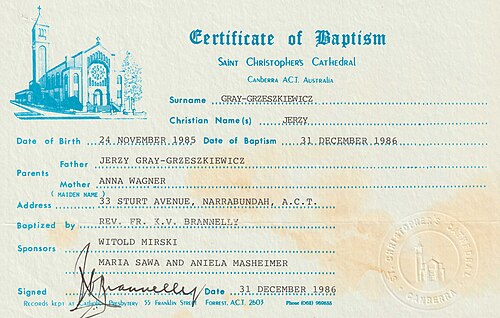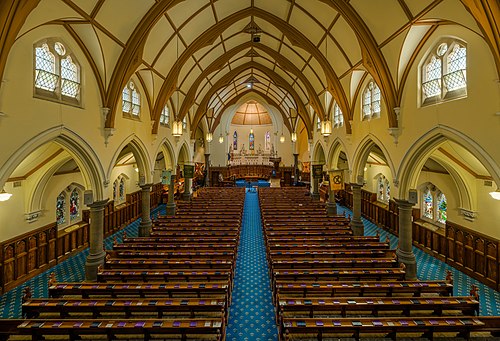
Church records in Australia are located primarily in either the local church, the diocesan registers office, church archives, state archives and/ or the library. Most church records will be found within the Catholic church since this the most common church within Australia[1]. For example, in the Catholic Church, records of events such as baptisms, marriages and burials, are maintained by local parishes but will also generally be recorded by the local diocese - which oversees multiple local parishes - through their record office[2]. Since nearly fifty percent of Australia are participants in one form or another in Christianity[3], Church records are of utmost importance.
Research your ancestors on MyHeritage
Church affiliations in AustraliaChurch affiliations in Australia
Nineteenth century AustraliaNineteenth century Australia
Australia has a long faith tradition, particularly within the Christian church, which until recent decades comprised the overwhelming majority of self-identified religious persons within the country. Being a former British colony, the majority of early Christians in Australia were members of the Church of England - later the Anglican Church in Australia,- while a significant number of early settlers also belonged to the Roman Catholic and Presbyterian denominations, due to significant numbers of Irish and Scottish settlers, respectively, within the early Australian colonies. By the later part of the nineteenth century, a sizeable Lutheran community had also developed, comprised mostly of German settlers who settled mainly in South Australia and to a lesser degree the Western district of Victoria.\
Twentieth century AustraliaTwentieth century Australia
Throughout the 20th century, numerous other Christian denominations within Australia grew into sizeable communities, due to various factors including increased levels of overseas migration, divisions and mergers within existing churches and other cultural influences. The most noteworthy of these were the Uniting and Methodist churches among the local-born population, while significant migration from Eastern European countries led to the formation of a sizeable Eastern Orthodox community within the country. Australia’s religious profile was also significantly altered throughout the second half of the twentieth century by heavy post-war migration from Southern Europe, and in the 1970s from Southeast Asia during and following the Vietnam war, leading Catholics to overtake Anglicans as the largest religious group in Australia by 1986[4].Despite significant declines in the percentage of Australians self-identifying as Christian in recent decades, they still comprise the largest religious group by far, while Catholics and Anglicans still comprise the relative majority of Christians in Australia[4].
History and location of Australian church recordsHistory and location of Australian church records
History of Australian church recordsHistory of Australian church records
Church records in Australia have historically been a valuable source of information for documents relating to births, baptisms, marriages and burials. Before compulsory registration was progressively introduced throughout the Australian colonies during the mid-nineteenth century, vital information was collected and copied from church records[5].
Location of Australian church recordsLocation of Australian church records

Church records were collected, recorded and maintained independently by local church parishes, with different denominations having their own procedures for record keeping. Because of this, records can be challenging to locate. However, some church records continued to be recorded in general collections, including Australia Births and Baptisms 1792-1981[6], while state libraries within some Australian states and territories contain a selection of church parish registers from their respective states[7]. Additionally, some parish records will be recorded in parish or state archive collections[2].
What information is included in Australian church records?What information is included in Australian church records?
Australian church records will typically include the following kinds of records:
- Baptismal Records: These records often include the date of baptism, the name of the individual being baptized, their parents' names (including the mother's maiden name), and sometimes the sponsors or godparents.
- Marriage Registers: Marriage records typically include the names of the bride and groom, the date of the marriage, the names of witnesses, and sometimes additional details such as the couples' ages, occupations, and places of residence.
- Burial Records: Burial records provide information about individuals who were buried in the churchyard or cemetery associated with the church. They may include the date of burial, the name of the deceased, their age at death, and sometimes details about their family relationships.
- Other information: Additional records maintained in parish registers include information such as members of given church congregations, as well as details of key church events such as confirmations and other church sacraments.
See alsoSee also
- Australia
- Australian genealogy
- Baptism records
- Christening records
- Birth, death, and marriage records in Australia
Explore more about Australian church recordsExplore more about Australian church records
- Australia - Church Records record collection at MyHeritage.
- Australian Lutheran-1948 record collection at MyHeritage.
- Using MyHeritage for family history research in Australia at Legacy Family Tree Webinars
- Beyond the Church Register: Finding and using religious archives in Australia at Legacy Family Tree Webinars.
- How do I go about obtaining a copy of my Baptism certificate?.
- Society of Australian Genealogists
- Australian birth, death and marriage records at the National Library of Australia
- Hall, N. J. (1989), Parish registers in Australia : a list of all known originals, transcripts, microforms and indexes of Australian parish registers.
References
- ↑ https://www.abs.gov.au/articles/religious-affiliation-australia
- ↑ 2.0 2.1 https://www.familysearch.org/en/wiki/Australia_Church_Records
- ↑ https://www.abs.gov.au/articles/religious-affiliation-australia
- ↑ 4.0 4.1 Religious affiliation in Australia. Australian Bureau of Statistics
- ↑ BIRTHS, DEATHS AND MARRIAGES. State Library of New South Wales
- ↑ https://search.findmypast.com/search-world-records/australia-births-and-baptisms-1792-1981
- ↑ Researching your Victorian ancestors. State Library Victoria

